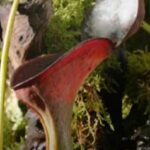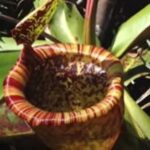As an Amazon Associate, this site earns commissions from qualifying purchases. For more details, click here.
Can your pitcher plant really eat flies? If you are having fly problems at home or in the garden, would it help to have a nepenthes or sarracenia plant there? This article covers the facts about pitcher plants, their diet and how big of a part flies play in their nutritional needs. As you will find out, these plants can be really useful here.
Pitcher plants eat flies for nutritional benefits. These plants produce nectar which lures flies into their trap. Once the prey is consumed, it is used by the plant to increase its energy resources.
How Many Flies Can Pitcher Plants Eat?
Pitcher plants have to eat at least one insect a month. Some species can be fed every week. If you want to feed multiple pitchers, reduce the frequency to every two weeks or every month.
There are no fixed rules on how often to give flies to pitcher plants. It can be once a month, once a week, and many species can survive without eating insects at all. As long as the plant gets sufficient light, water and humidity it will live. However, depriving them of insects will slow their development.
The other factor is the size and health status of the plant. A large, healthy nepenthes can probably eat more than one fly per month. A smaller nepenthes on the other hand, will be content with just one insect every four weeks.
if your pitcher plants are regularly fed they will not at as many flies. For instance, if you give your nepenthes Sera Catfish Chips every week, it will the plant’s nutritional requirements. There is no need for the plant to eat any more flies or insects. Some might fall into its pitchers but the plant may not at them because it is full.
If you want to feed your pitcher plant, keep track of how much food you are giving and how many pitchers. Because flies are so small you can probably give a few every week. You can always check the pitcher after a few days. If they are empty, it means the plant ate everything. If there are several flies left, the plant cannot handle that much food.
Can Pitcher Plants be Overfed?
Pitcher plants should not be overfed. Forcing them to eat more than they need could cause serious damage. These plants usually have a built in mechanism to prevent this, but it is still a good idea to avoid force feeding.
Nepenthes, sarracenia and other pitcher plants eat flies for nutrition. They grow in bogs, wetlands and tropical locations, all of which have poor soil. Because the ground lacks nitrogen and other elements, these plants have to get them from their prey.
It just so happens that flies and other insects have these elements, so plants developed traps to capture these insects. When a nepenthes catches a fly, it is consumed and turned into nitrogen, calcium, potassium etc.
Pitcher plants will only eat flies when they need nutrients. If this is already met, the plant will not eat any more. You can drop as many bugs as you want in the pitchers, but the plant will not consume them.
At least that is how most pitcher plants behave. Some of them try to eat as many insects as it can. This could cause a lot of problems.
Related. How to keep pitcher plants alive
One, trapping, releasing digestive fluids and eating insects consumes a lot of resources. Pitcher plants give up a lot of energy to eat, but they do because they get nutrients in return. More energy goes in compared to what is used, so it is good for the plant.
But if you constantly feed a pitcher plant, resources will dry up. The plant could end up using more energy to digest the food than it has. Under this scenario, your pitcher plant might not have the energy needed to digest the fly. Bottom line is do not overfeed your pitcher plant under any circumstances.
How Pitcher Flies Eat Flies and Other Bugs
Whether you have nepenthes or sarracenia, they use the same methods to capture and eat flies. Their techniques apply to other bugs as well.
Pitcher plants use a sweet substance called nectar to lure flies and other bugs. Once caught, the plant uses digestive enzymes to dissolve its prey and eat it.
Because pitcher plants are fixed to their spot, they cannot hunt for prey. Instead they have traps to draw flies, ants and other insects.
The key is the nectar. If you touch a pitcher plant (and you should not), you will notice the pitcher rim feels slippery. That is the nectar moisture which nepenthes uses to attract flies and other insects.
When a fly gets to smell the nectar, it will go over to the pitcher. When the fly lands on the pitcher edge to eat it, the surface causes them to slip into the cupped leaves or cavity.
Each pitcher contains viscous fluids which prevents flies from using their wings to escape. Some pitcher plants have bacteria that break down insect tissues. Other pitcher liquids have insect larvae that feed on any bug that falls into it. The larvae consumes the fly and in turn its waste is absorbed by the plant and converted into nutrients.
The digestive process might take several days. If you look into its pitcher you might find bits of leftover insects. And if you see a lot of bugs, that means the plant was not able to consume them all. You might want to remove those bugs so they do not decay inside the pitcher.
Why is My Pitcher Plant Not Eating?
There are many reasons why pitcher plants may suddenly stop eating. Disease, dormancy, and lack of humidity are among the most likely reasons.
Disease. A sick pitcher plant will not be able to eat. Root rot, insect infestation, bacterial or fungal infection are some of the most common plant diseases.
Symptoms include a a foul smell, leaves turn brown or black, yellowish pitchers and pale colors. The plant looks shriveled and weak. Its roots are mushy and smell bad. These are indications the plant is seriously ill.
Lack of humidity. Pitcher plants require at least 30% humidity. The higher the humidity level, the more liquids the plant can produce for its pitchers. These fluids are needed to trap insects that fall into the pitcher. Without these, those bugs will be able to escape. Using a fogger or humidifier can help. One that works well with pitcher plants is the AquaOasis Cool Mist humidifier.
Too much heat. Pitcher plants need light more than heat. Too much heat can dry out the leaves, the nectar on the pitcher and its liquids. The best temperature range is 65-85 degrees F though other variants can tolerate 90 degrees.
Dormancy. If your pitcher plant goes dormant, it will stop eating. This is normal. Just make sure the plant is in the right environment to survive winter and come back in the spring.
Some pitcher plants go through dormancy but others do not. If yours does not and winter is approaching, take it indoors. Nepenthes for instance, are tropical plants and cannot withstand harsh winter freezing.
Sarracenia pitcher plants undergo winter dormancy so they should be fine outdoors. Most of them can handle zone 6 and 7 winter conditions. Few can cope with zone 5 winters outdoors however.
Do Pitcher Plants Attract Flies?
Because pitcher plants produce nectar, could they make your fly problem worse by attracting them? The answer is no.
While nepenthes will draw flies, the nectar keeps the insect off your food. If there is a fly in the vicinity, the pitcher will draw its attention away from your food. This is what makes it an effective fly catcher.
Of course pitcher plants can only eat a limited number of flies. For most homes that is enough. If you just want to get rid of a few flies, a nepenthes or two will do. So you do not have to worry about the plant causing more trouble by attracting flies and other insects.
Conclusion
Pitcher plants are not pest controllers, but they can be effective under the right circumstances. If you just want to get rid of the occasional housefly or fruit fly, these plants will be more than enough. For large scale fly infestations, it is better to find the source of the problem first.

My fascination with carnivorous plants began many, many years ago with Venus Fly Traps. Now I am more than happy to impart what I know with other enthusiasts and those who are curious about meat eating plants.



